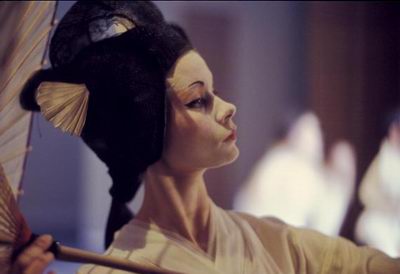
While pursuing research into the career of designer Kristian Fredrikson I was surprised to find Fredrikson’s name mentioned in production credits for Yugen, Robert Helpmann’s 1965 one-act work for the Australian Ballet. Fredrikson, whose home base was Melbourne at the time Yugen was being created, is listed, along with William Miles, as having made the headdresses.
Yugen was designed by Desmond Heeley who tells me that he worked on the designs in London and sent the drawings to Australia by mail with copious instructions to the wardrobe department at the Australian Ballet. Helpmann requested, however, that the costume for the leading role of the Goddess, danced in the original production by Kathleen Gorham, be made by costume makers who had worked with him on previous occasions at Sadler’s Wells and Covent Garden, including Hugh Skillen who made the very delicate headdress worn by Gorham and those who followed in the role.
Fredrikson’s interest in headdresses and wigs—millinery in general—can be traced back to his very first works made in New Zealand. For what is reputed to be his first theatrical commission, the Strauss operetta A Night in Venice, one reviewer wrote:
An intriguing effect has been created for the doxies in the opera by giving them flowing wigs in vivid purple, green, blue and orange. Making these wigs occupied two days—they had to be dyed, teased, shaped, curled, brushed and, where necessary, lacquered.
His interest in framing the face in some way can also be followed throughout his career and many of his designs on paper contain detailed instructions to the millinery department of the companies for which he worked.
In 1965 Fredrikson had just a few design commissions behind him, perhaps the most prestigious being designs for Aurora’s Wedding for the Australian Ballet in 1964. Making the Yugen headdresses to Heeley’s designs was no doubt an important and prestigious step for him and he often mentioned Heeley as an influence on his own work.

For more images of Yugen follow the link.
Michelle Potter, 21 October 2011